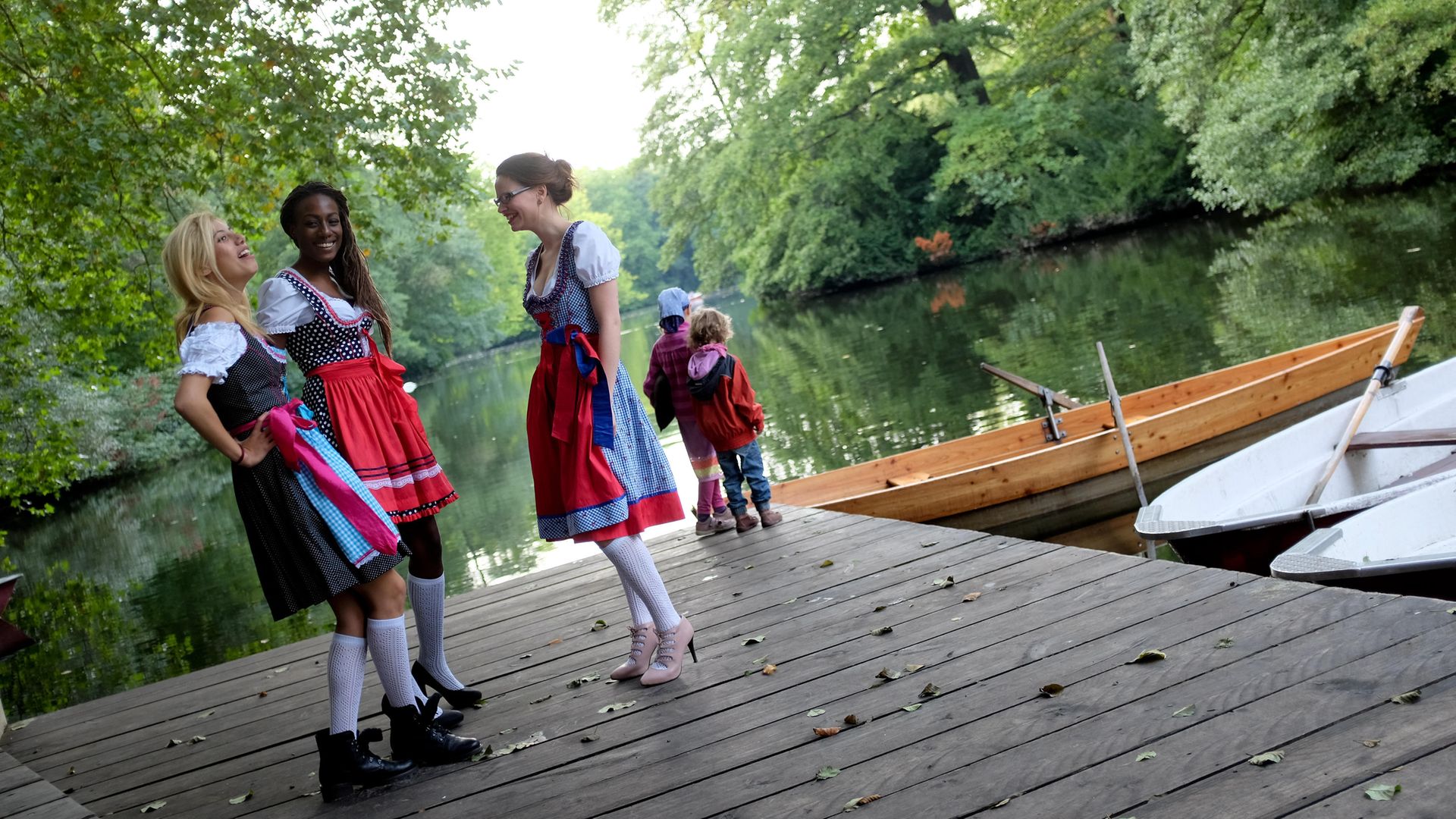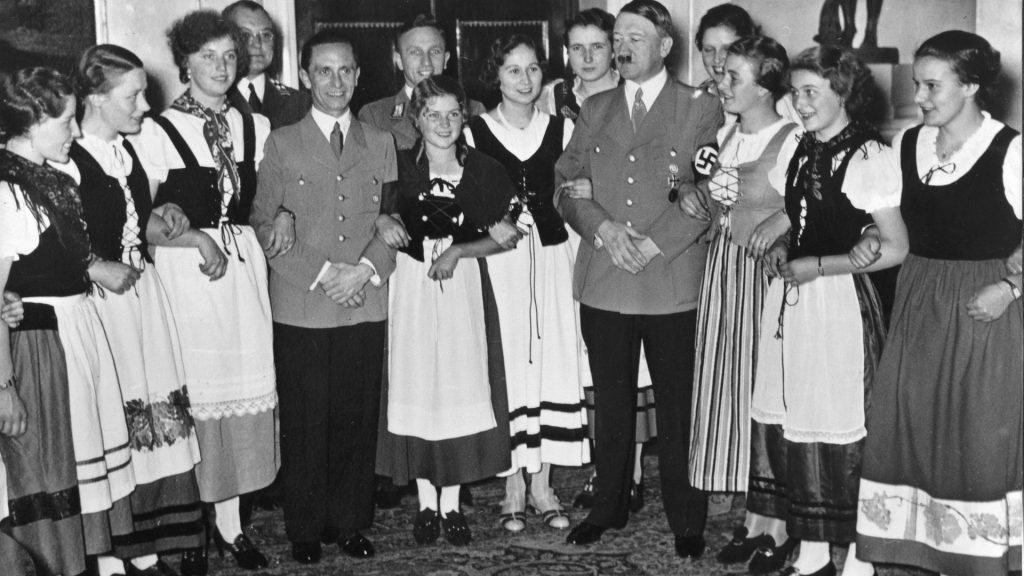
HELEN PARKINSON on the history of the dirndl, a clothing co-opted by the Nazis but which has successfully shrugged off this association.
Its feminine frills are more likely to conjure images of Oktoberfest’s beer-slinging or Julie Andrews spinning on a hillside than a catwalk. But when fashion designer Vivienne Westwood, on a visit to Austria in 2001, said “there would be no ugliness in the world if every woman wore a dirndl”, it was a harbinger of the Alpine folk dress’ unlikely style renaissance.
From a star turn at the Dolce & Gabbana show during Milan Fashion Week to Kim Kardashian, no less, channelling Heidi on holiday in Munich, the dirndl was back in vogue – not least in its mountain home, where it remains a wardrobe staple. Buried beneath the petticoat layers, however, lies a troubled past.
The dirndl we know today – a smart bodice, blouse, skirt and apron ensemble – has its roots in the 19th century. At this point, the dress and its fetching male counterpart, the lederhosen, were the garb of the rural population of the eastern Alps. Stretching from Switzerland in the west, through Liechtenstein, Austria, northern Italy and Bavaria, this tracht (the German word for traditional clothing) was worn for working the land. But a new hankering for provincial culture among the upper classes would see it broach new territory, swapping its natural habitat of the mountain meadows for the gilded splendour of the royal palaces.
Tracht became entwined with the dawn of romantic nationalism – the importance of local customs and traditions in forming a national identity. Europe had been left licking its wound after the Napoleonic Wars ended in 1815 and the states affected by the conflict wanted to rediscover their national identity – or what was left of it. In Bavaria and Austria, this triggered a fresh interest in cultural heritage: folk art, music, literature and, of course, fashion, were to become the latest fad.
At today’s Oktoberfest, the unofficial tracht uniform is donned with glee by Germans and tourists alike, but things were very different at the first event. The inaugural Oktoberfest in 1810 was a horse race to celebrate the nuptials of the future King Ludwig of Bavaria and his wife, Queen Therese.
Alas, unlike the modern festival, there was not a pair of ill-fitting leather breeches or a sky-high skirt in sight. The academic Simone Egger, author of The Oktoberfest Tracht Phenomenon, notes that Munich’s residents were given then-fashionable French-inspired outfits to wear to the celebrations, instead of their normal clothes.
Yet, in a change of fortune 25 years later, tracht would be the guest of honour at Oktoberfest. A parade of folk costumes at the 1835 festival were among the celebrations for the silver wedding anniversary of Ludwig and Therese. A further royal seal of approval came from Ludwig’s successor, King Maximillian II of Bavaria, who allowed tracht to be worn at the royal court. The Bavarian bourgeoisie followed his lead in adopting the rustic fashion and soon, the dirndl was no longer the preserve of the countryside.
Seeing the dirndl make fashion strides among the upper classes led to a resurgence in favour for tracht among the general population – and two entrepreneurial brothers spied a business opportunity. Julius and Moritz Wallach moved from Bielefeld in north-west Germany to Munich in 1890, where they became enamoured with their new home’s folk traditions. Inspired by the designs worn by the wealthy Bavarians holidaying in the southern Alpine resorts, they began to produce exquisite, hand-printed dirndls and sold them from their Munich boutique.
Word spread fast, and the Wallach brothers quickly made a name for their designs in the city. Their dresses appeared at the centenary celebrations for Oktoberfest in 1910. They soon became in demand outside the city confines, with one of their designs being worn by Prussian royalty. Their work was even snapped up by the theatre world, appearing in the operetta Im Weissen Rössl (The White Horse Inn). Offstage, they cannily marketed the dirndl to the masses during the First World War as a casual summer dress and its popularity boomed.
But as the flames of Nazism started to burn through German and Austrian society, the Jewish Wallach brothers’ flourishing business was fatally hurt. To promote the idea of a Pan-Germanic identity, the Nazis seized the same ideas of the nationalism movement of the previous decade and appropriated dirndls, lederhosen and other symbols of folk culture for sinister gain. The dirndl’s homely, feminine image was co-opted and used in propaganda photos of the time portraying Aryan ideals.

Under the Nazi regime, Jewish people were banned from participating in folk culture – something the Wallachs and other Jewish families had played an instrumental part in helping to develop. Julius and Moritz fled to the United States, while their other brother, Max, died in Auschwitz in 1944.
The damage was done to the dirndl. What was once an innocent dress now seemed to be tainted for a generation. While rural folk continued to wear the clothes of their heritage, tracht fell out of fashion in the cities after the war, contaminated by its far-right associations. But as the decades passed, and memories began to fade, enthusiasm for the traditional clothing swelled once more.
The Munich Olympics of 1972 was a first marker of tracht’s return; the hostesses’ official uniforms were bright blue dirndls that made a striking impression on the new colour broadcasts on TV screens worldwide. As the 21st century arrived, the dirndl had become a wardrobe staple for young and old in the Alps once again.
Like schlager music and schuhplattler, Alpine folk costumes are far more than a stale cliché – they are part of the cultural fabric of the Alps. Just bag an invitation to a Tyrolean wedding, Viennese ball or the Oktoberfest itself to see for yourself. All the industry’s major players have boutiques in Munich, like Gössl, the family-run firm from Salzburg. The ornate dresses in the windows of its chic Residenzstraße store can cost four figures.
For some commentators in the German media, there remains a lingering right wing association with tracht. Dirndls and lederhosen, with all the trimmings like the traditional Tyrolean hat, are a common sight at events for the more conservative-leaning political parties, for example the FPÖ, Austria’s right-wing ‘Freedom Party’.
That said, Austria’s president, Alexander Van der Bellen of the centre-left Green Party also took to donning lederhosen instead of his usual suit on the campaign trail in 2016 in an effort to win over the rural voters. Could his leather breeches have been the winning ticket?
Back at the Wiesn, hashtags like #dirndlliebe (dirndl love) and #wiesnmadl (Oktoberfest girl) trend on Instagram every September, showcasing a rainbow of dirndls. Traditional dirndl manufacturers are making use of social media to keep the new generation of tracht enthusiasts on side.
In 2019 Krüger, a brand with over 60 years of history, launched a blogger collection teaming up with key social media stars like German fashion blogger Leonie Hanne and Austrian singer Victoria Swarovski to create their own dirndl designs. Traditionalists may shudder, but it’s an undeniably novel way of keeping a centuries-old fashion alive for many years to come. Prost to that!









